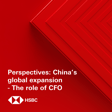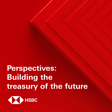Become a Creator today!Start creating today - Share your story with the world!
Start for free
00:00:00
00:00:01

Under the Banyan Tree – Catching up on commodities with Paul Bloxham
Paul Bloxham, Chief Economist for Global Commodities, joins Fred for a wide-ranging chat, including the impact of China’s downturn and how climate change and the energy transition have become powerful forces for demand. Disclaimer: https://www.research.hsbc.com/R/101/PlpGv2S . Stay connected and access free to view reports and videos from HSBC Global Research follow us on LinkedIn https://www.linkedin.com/feed/hashtag/hsbcresearch/ or click here: https://www.gbm.hsbc.com/insights/global-research.
Hosted on Acast. See acast.com/privacy for more information.
Transcript
Introduction to HSBC Global Viewpoint
00:00:02
Speaker
Welcome to HSBC Global Viewpoint, the podcast series that brings together business leaders and industry experts to explore the latest global insights, trends, and opportunities.
00:00:13
Speaker
Make sure you're subscribed to stay up to date with new episodes.
00:00:16
Speaker
Thanks for listening.
00:00:17
Speaker
And now onto today's show.
00:00:24
Speaker
This is a podcast from HSBC Global Research, available on Apple Podcasts and Spotify.
00:00:30
Speaker
However you're listening, analyst notifications, disclosures, and disclaimers must be viewed on the link attached to your media player.
Topics Overview: Climate, Geopolitics, Energy
00:00:46
Speaker
Hello and welcome to Under the Banyan Tree.
00:00:48
Speaker
I'm Fred Newman, Chief Asia Economist, coming to you from Hong Kong.
00:00:51
Speaker
We're hitting a string of hot topics on the show today from climate change to geopolitics and the energy transition.
00:00:58
Speaker
What ties all of those together?
00:00:59
Speaker
The answer is commodities.
00:01:02
Speaker
I'm delighted to welcome our Chief Economist for Global Commodities, Paul Bloxham, back onto the podcast from HSBC Global Research.
00:01:09
Speaker
You're listening to Under the Banyan Tree, where we put Asian markets and economics in context.
Why are Commodity Prices High?
00:01:28
Speaker
So we last discussed commodities on the podcast back in September last year.
00:01:33
Speaker
At the time, we were asking what was keeping prices elevated given the Chinese economic downturn.
00:01:38
Speaker
Since then, commodity prices have actually held up really well and even rallied over the last two or three months about 10%.
00:01:45
Speaker
Let's bring in Paul Bloxham from Sydney for a closer look at why that is.
00:01:49
Speaker
Paul, great to have you back with us.
00:01:51
Speaker
It's great to be here.
00:01:53
Speaker
Paul, you cover commodities and have for many, many years.
00:01:56
Speaker
And, you know, let's take a step back before we delve into details.
00:02:00
Speaker
Just looking at a chart, commodity prices are still extremely high.
00:02:05
Speaker
If you take out sort of the spike around the, you know, Ukraine invasion, we're actually probably around record highs.
00:02:12
Speaker
How do you explain that?
00:02:14
Speaker
Because the global economy isn't overly strong and yet commodity prices are here hovering around record highs.
00:02:21
Speaker
Why is that?
Supply Constraints & Geopolitical Factors
00:02:22
Speaker
So we come at it from a couple of different directions.
00:02:24
Speaker
I guess the first one is to say commodity prices are quite elevated because the supply side of commodities is quite constrained.
00:02:32
Speaker
We've written quite a bit about this over the past couple of years and we've referred to it as a super squeeze, a global super squeeze in the commodity space.
00:02:39
Speaker
We think that there just hasn't been enough supply available to meet the given demand, even though demand, as you say, hasn't been that impressive in the scheme of things.
00:02:48
Speaker
And that's left the prices at more elevated levels.
00:02:51
Speaker
We've been talking about the super squeeze occurring across three key structural dimensions.
00:02:56
Speaker
Geopolitics playing a role in terms of constraining and rearranging supply, climate change, and in particular, of course, the impact that has on agricultural commodity supply and also the energy transition, which means we're shifting the way we produce energy, but it means much, much higher demand for the products that go into trying to make that energy transition, the metals associated with it, but less investment in fossil fuel capacity.
00:03:21
Speaker
just something that also constrains the supply of commodities and maintains those prices at higher levels.
00:03:26
Speaker
That's, in our view, the primary driver of why we're in the position we are.
00:03:30
Speaker
I think one other element we've been adding a bit more recently is to say, look, keep in mind that although nominal commodity prices, i.e.
00:03:37
Speaker
we look at commodity prices typically in US dollar terms, are high, they are high, actually if you compare commodity prices
00:03:45
Speaker
to the rest of the consumer goods.
00:03:48
Speaker
So you look at them in real terms, you compare them to, say, the US CPI, they're actually not that high.
00:03:53
Speaker
They're really close to their average because we have been through in the past couple of years this very big step up in inflation and the price level.
00:04:01
Speaker
And so it's not as high when you look at it in real terms.
00:04:03
Speaker
So I think those are two helpful ways to think about why we are where we are.
Commodity Price Rally & Industrial Cycle
00:04:08
Speaker
So you mentioned big structural drivers here.
00:04:11
Speaker
You mentioned climate change.
00:04:12
Speaker
You mentioned geopolitics.
00:04:15
Speaker
You mentioned the energy transition, all affecting commodity prices.
00:04:19
Speaker
But then if you hone in a bit more to recent data, we've actually seen a pretty convincing rally.
00:04:26
Speaker
Since about February, commodity prices are up 10%, 12%.
00:04:31
Speaker
there must be some cyclical signaling here as well.
00:04:35
Speaker
Does that mean the global economy is picking up steam again?
00:04:38
Speaker
Or do you think that more recent rally is divorced from these shorter term cyclical trends that we're seeing?
00:04:45
Speaker
No, I think that's definitely an element of our story too.
00:04:47
Speaker
So you're right that we just described the big picture.
00:04:50
Speaker
But if you get right into the sort of shorter term, we have seen an upswing in commodity prices.
00:04:55
Speaker
There are about
00:04:56
Speaker
as you say, about sort of 10 or 11% off their trough.
00:04:59
Speaker
They're about that much up year to date.
00:05:01
Speaker
And I think part of it, as you say, reflects that the global industrial cycle is starting to lift, showing more positive signs.
00:05:08
Speaker
We wrote a short piece a little while ago, we called it Dr. Copper and the Super Squeeze.
00:05:12
Speaker
And typically, market participants watch the copper price quite closely because copper is such a ubiquitous and highly used industrial commodity that when it goes up,
00:05:23
Speaker
When it goes down, it might be signaling, giving you an early sign as to what's going on in that industrial cycle.
00:05:29
Speaker
So it would be telling us at the moment that we are past the trough in the industrial cycle as well.
00:05:34
Speaker
So that's interesting.
00:05:35
Speaker
We're past the trough in industrial cycles.
00:05:37
Speaker
Of course, a lot going on, and we can unpack that a little bit later.
China's Demand Shift & Manufacturing Role
00:05:41
Speaker
But let me ask you about the role of China here, because China dominates the demand for commodities.
00:05:46
Speaker
And yet the new set of China is not very encouraging in terms of economic growth.
00:05:51
Speaker
And in particular, the housing market, which is a massive, massive user of certain commodities, has been down for two years.
00:05:59
Speaker
Construction is down 60 percent since its peak.
00:06:02
Speaker
So given the slowdown in China, in particular construction, why haven't we not seen commodities react more?
00:06:09
Speaker
Is that really a supply squeeze issue or is something else going on here?
00:06:14
Speaker
Well, I think it's firstly, I mean, it is somewhat surprising.
00:06:17
Speaker
If you sit back and say to yourself, you know, China has weakened the property sector, has been going backwards for quite some time now.
00:06:22
Speaker
And the fact that the commodity prices have held up so well might be somewhat surprising.
00:06:27
Speaker
I think one element of that story is the super squeeze that I've just described on the supply side, but that can't get you all the way.
00:06:34
Speaker
A part of the story is also that although you've got a very weak property sector, property investment in China, you are seeing a reorientation of growth.
00:06:42
Speaker
They're moving growth more towards
00:06:44
Speaker
They're investing in the manufacturing sector, they're ramping up production of things that go into the energy transition, particularly that's not just driven in some ways, it's driven by China and its demand for those products, but it's also driven by the rest of the world.
00:06:56
Speaker
We're making the energy transition across the world.
00:06:58
Speaker
We're making it in the US and Europe, in Japan, the rest of the countries, governments are stepping up and doing more spending.
00:07:04
Speaker
And of course, a lot of those products that go into that get produced in China and then exported to the rest of the world.
00:07:11
Speaker
So that I think is a really, really big part of the story because if you look at the sorts of commodities where you're seeing prices that have lifted, copper is one, nickel is another, aluminium is another.
00:07:21
Speaker
These are products that are partly supply constrained to a degree for the reasons we talked about earlier, but they're also all key parts of what is the energy transition.
00:07:29
Speaker
So I think that energy transition overlay, that story,
00:07:32
Speaker
is affecting China directly is a global story, but it's also a driver of why China's demand for commodities has remained so robust in the face of weakness in the property sector.
00:07:42
Speaker
And I want to come back to the energy transition and climate change in particular.
00:07:46
Speaker
But before we do that, you know, there's another economy that's often talked about in terms of generating demand.
00:07:53
Speaker
India has been on the roll.
00:07:54
Speaker
Growth is very robust there, most populous nation on earth.
00:07:58
Speaker
And a lot of analysts have kind of drawn this parallel with China, saying that, well, at some point,
00:08:05
Speaker
India should deliver an enormous increase in commodity, man, just as China did in its kind of accelerating growth phase.
00:08:12
Speaker
Have we seen evidence of that yet with India stepping in a major way into commodity markets?
00:08:17
Speaker
And would you expect it over a time frame of like, say, the next five years or so?
India vs China: Commodity Demand
00:08:23
Speaker
I don't think it's going to be as big a story as China.
00:08:26
Speaker
And I guess there are a few different dimensions.
00:08:28
Speaker
I mean, it's certainly the case that India's growth prospects are looking better and it's building a lot more infrastructure.
00:08:33
Speaker
It's doing things that can be seen as commodity intensive.
00:08:36
Speaker
But it's hard to see that that's going to ramp up in the sort of scale that we saw in terms of China's emergence through the early part of this century.
00:08:44
Speaker
So that's one element.
00:08:45
Speaker
I think the next element is China's pathway to growth.
00:08:48
Speaker
was to become an enormous global manufacturing, the factory of the world.
00:08:53
Speaker
And that's where they've gotten to.
00:08:55
Speaker
And so, you know, that is a highly commodity intensive activity.
00:08:58
Speaker
And it's not that they're the source of demand for the commodities.
00:09:01
Speaker
Actually, the end demand goes to other countries where they sell those manufactured products.
00:09:05
Speaker
It does seem as though India's growth pathway is going to be a different one.
00:09:08
Speaker
It's going to be much, much more services oriented, so likely less commodity intensive.
00:09:14
Speaker
And so,
00:09:15
Speaker
For those two key reasons, and they're not the only ones, but we don't think India is going to be the same sort of scale in terms of sort of driving demand for commodities that China delivered through the first couple of decades of this century.
00:09:28
Speaker
So that's interesting.
00:09:29
Speaker
So the key to the global demand story really means China in many ways in all its aspects, even if China's demand itself is shifting to other sectors.
00:09:37
Speaker
Maybe this is a great place to take a quick break.
00:09:40
Speaker
And when we come back, we want to talk a little bit more with Paul on this idea of the energy transition, its impact on global commodities and also climate change.
Energy Transition: Impact on Fossil Fuels
00:09:59
Speaker
Well, we're back with Paul here.
00:10:00
Speaker
We just talked about some of the broad drivers of global commodity prices and the fact that China is still one of the key demand areas for commodities.
00:10:10
Speaker
But Paul, you mentioned the energy transition, and I wanted to unpack that a little bit.
00:10:15
Speaker
There are two aspects on this.
00:10:17
Speaker
One is the impact of the energy transition on traditional fuels like oil, coal and gas, for example.
00:10:25
Speaker
And the other one is on new materials.
00:10:27
Speaker
And maybe let's start with the fossil fuel aspect first, because oil prices, when I look at this, still $83 for Brent or so at the time of recording.
00:10:37
Speaker
That's still pretty pricey.
00:10:40
Speaker
I guess some of the other energy prices for fossil fuels, gas, do remain somewhat elevated.
00:10:46
Speaker
We haven't really seen that dip in demand, have we, or the impact on prices?
00:10:51
Speaker
How do you explain that?
00:10:52
Speaker
Well, we still seem to be hitting new daily or quarterly usage rates for oil.
00:10:58
Speaker
We're hitting new highs.
00:10:59
Speaker
We're still not quite
00:11:00
Speaker
at peak oil demand.
00:11:02
Speaker
So that's one feature to keep in mind.
00:11:04
Speaker
But I think, I mean, that will come at some point and it's difficult to predict, but you'd see that that would likely play out.
00:11:09
Speaker
But the big story here is that OPEC has been very, very cohesive.
00:11:14
Speaker
They've managed to keep a lot of oil off the global market at the moment.
00:11:19
Speaker
OPEC has got sort of 5.6 million barrels a day out of
00:11:24
Speaker
about 101 million barrels a day is what we use globally.
00:11:27
Speaker
5.6 million barrels a day of global supply is being constrained, mostly Saudi supply, by their choice not to put that onto the global market.
00:11:36
Speaker
Actually, this is very sort of timely because we've got another meeting coming up this weekend, of course, of OPEC, and there's a question around whether they'll continue to extend the cuts they've got in place at the moment, and that's likely to happen.
00:11:49
Speaker
Again, that's being reflected in
00:11:50
Speaker
the oil price staying at the levels you're talking about, $83 a barrel.
00:11:53
Speaker
So that's part of the story.
00:11:55
Speaker
I think the gas, I mean, gas is partly also, you've got to keep in mind, what you'd see is a sort of transition fuel where you're shifting from a higher carbon emitting fuel, like say coal, to using gas in the interim while you're making the full energy transition towards renewables.
00:12:11
Speaker
So that's continuing to support demand for gas.
00:12:14
Speaker
And actually there is quite a lot of new construction going on
00:12:18
Speaker
in liquefied natural gas capacity over the coming years that's going to come on stream from Qatar, the US, Canada.
00:12:25
Speaker
And so that's bringing more gas onto the global market.
00:12:28
Speaker
But again, the energy transition, as I think we've talked about on this podcast before, it's a long game, right?
00:12:34
Speaker
It's a multi-decade proposition.
00:12:36
Speaker
It's a long game.
00:12:37
Speaker
And as you say, there's still plenty of demand for oil and gas, unfortunately, for the global environment.
00:12:42
Speaker
But still, if you think about China, China's leading in terms of the
00:12:48
Speaker
adoption of electric vehicles, for example.
00:12:50
Speaker
It's the largest import of oil globally.
00:12:53
Speaker
Do you see any sense that maybe Chinese demand is at the margin slowing because of EV adoption?
00:13:00
Speaker
Or is that still a long way away?
00:13:03
Speaker
I think 30% of cars in China now are electric vehicles.
00:13:07
Speaker
So is that starting to make a dent?
00:13:10
Speaker
I still think that China is growing fast enough.
00:13:13
Speaker
that actually you've still got demand for all of these things continuing to grow at this point.
00:13:17
Speaker
So you get both the transitions to the electric vehicles, which drives the demand in that sense.
00:13:23
Speaker
You might think that as you move to electric vehicles, you reduce your oil demand.
00:13:26
Speaker
But if your economy is continuing to grow, you'll get more oil demand as well.
00:13:30
Speaker
So at the moment, I don't think there's that many signs that that broader transition has happened.
00:13:34
Speaker
But the projections suggest that, you know, that will be what we should look out for.
00:13:37
Speaker
That's coming in terms of that transition.
00:13:40
Speaker
And China is, as you say, doing a lot of,
00:13:43
Speaker
investment in the energy transition, making a lot more electric vehicles.
00:13:46
Speaker
I guess Europe is the leading area where this has been happening, but China is making a lot of progress in that direction too.
00:13:52
Speaker
So it's definitely a turning point we should look out for.
00:13:55
Speaker
So you mentioned China's enormous investment in electric vehicles, for example.
00:13:59
Speaker
That also raises the question of demand for battery metals, be it copper, lithium, for example.
00:14:08
Speaker
Have we seen a big rise in the price of these commodities?
00:14:12
Speaker
I know a few years ago, we all were worried that the world is going to run out of lithium.
00:14:16
Speaker
We wouldn't have enough lithium for these batteries.
00:14:18
Speaker
But how do you see that ramp up in battery capacity
00:14:22
Speaker
construction capacity in China impacting global commodity prices.
00:14:26
Speaker
Is there a real constraint here?
00:14:28
Speaker
So this is the really big story in the metal space.
00:14:31
Speaker
You know, as we talked about before, it's a part, a key reason why copper prices are over 10,000 a ton at the moment and why there are increasing financial players taking long positions in this area as well.
00:14:43
Speaker
So there's buildup of Chinese inventories at the moment, which partly reflects this expectation.
00:14:47
Speaker
There's going to be this really sustained long-term demand for copper.
00:14:50
Speaker
And there isn't actually that much investment going on globally in new copper mine production, despite the strong demand story.
00:14:58
Speaker
So this is, I think, very, very clearly a part of the reason why copper prices are staying elevated.
00:15:03
Speaker
You can draw that out further to nickel prices, which are also high at the moment, again, reflecting a similar story.
00:15:09
Speaker
Aluminium is actually more intensely used in the production of electric vehicles than in normal combustion engine vehicles.
00:15:15
Speaker
It's a lighter material, so it's partly reflecting that story.
00:15:18
Speaker
And then, of course, you get into the other ones.
00:15:20
Speaker
the critical minerals and you named one which is obviously the lithium story.
00:15:24
Speaker
I mean, lithium's got some very unique dynamics because a couple of years ago, there was such an enormous amount of demand for it that the price went up substantially.
00:15:32
Speaker
It went up 800% or 900% and that did motivate a massive upswing in investment and that investment was able to be brought on fairly quickly, unlike some of the other commodities.
00:15:43
Speaker
So through 2023, the story for lithium actually was that we got an oversupply.
00:15:48
Speaker
We got a
00:15:49
Speaker
Lithium prices fell a long way from their highs because we had more supply of the product and we'd had some sort of a slowdown a little bit in Chinese uptake of electric vehicles.
00:15:59
Speaker
We've had a bit of a slowdown in the US as well.
00:16:01
Speaker
So that all combined to get lithium prices to come right back down.
00:16:04
Speaker
They've stabilized recently and I think our view is they're going to sort of stabilize and start to lift again.
00:16:09
Speaker
But the medium term story is we still need a lot more lithium because we're going to use a lot more batteries in the energy transition.
00:16:16
Speaker
Well, I guess the good news here is that we have enough lithium around to actually fuel that energy transition.
Climate Change & Agriculture Impact
00:16:21
Speaker
And I suppose the high prices for copper and other materials ultimately will help to ensure supply as well.
00:16:28
Speaker
But perhaps one last question related to this, which is climate change.
00:16:32
Speaker
And of course, the energy transition is motivated by concerns over climate change.
00:16:37
Speaker
And that's the impact on the agricultural market.
00:16:40
Speaker
You know, just opening newspapers, you see always news about extreme weather patterns coming through.
00:16:46
Speaker
And I'm struck that rice prices, which are very important for us here in Asia, are actually, you know, very elevated multi-year highs, certainly highs since about 2008 about.
00:16:59
Speaker
Is there more we should worry about, about the impact of extreme weather patterns on agricultural prices?
00:17:04
Speaker
And should the Asian population
00:17:06
Speaker
consumer worry about that impacting their pocketbooks.
High Commodity Prices & Inflation Risks
00:17:10
Speaker
We're keeping a very close eye on this story for good reason and you are seeing actually a pickup in agricultural commodity prices over the past few months as well like we talked about with the other products and a lot of that is more inclement weather than the normal.
00:17:24
Speaker
So for rice, we saw this big rise in rice prices through last year in part because of trade restrictions that were put in place in India
00:17:31
Speaker
and that constrained the global market of rice.
00:17:33
Speaker
Rice prices came down a little bit in the early part of this year, but just in the past little while, since middle of April, they've actually risen again.
00:17:40
Speaker
And they're almost, at least on the Thai white rice price, near a 15 year high.
00:17:45
Speaker
And that's because of weather.
00:17:46
Speaker
We've got weather affecting chocolate and orange juice prices, coffee prices.
00:17:51
Speaker
And I think one, that's related to climate change and more extreme weather events.
00:17:56
Speaker
So to your point, Fred, that we have to watch this very carefully, but the other,
00:17:59
Speaker
sort of bringing it back to where we are at a macro level, we have to think that this collection of things we're talking about, we're seeing prices lift off already quite high levels.
00:18:09
Speaker
It means that inflation, which still hasn't come down quite to where it needs to be in most countries, might prove to be a bit stickier.
00:18:16
Speaker
And that's one of the other themes we've been running that what can we learn about commodities, the demand and the supply dynamics, what can it mean for the broader inflation story?
00:18:26
Speaker
And of course, that means something
00:18:27
Speaker
potentially for interest rates in central banks as well.
00:18:30
Speaker
Paul, thank you very much for joining us.
00:18:32
Speaker
And I guess we'll check in again with you in a few months to see where we are in commodity prices.
00:18:36
Speaker
But it's really remarkable how resilient the sector has been.
00:18:40
Speaker
And you really highlight in your research some of these very fundamental drivers.
00:18:46
Speaker
And we invite anybody who's listening to check out Paul's research.
00:18:50
Speaker
So thank you very much, Paul.
00:18:52
Speaker
Thanks, Fred.
00:18:52
Speaker
Cheers.
00:18:54
Speaker
And that's all we've got time for, ladies and gents.
00:18:57
Speaker
Thanks, as always, for joining us under the banyan tree.
00:18:59
Speaker
Remember, for a global take on this week's top economic stories, check out our sister podcast, The Macro Brief, available wherever you're listening right now.
00:19:08
Speaker
We'll be back again next week.
00:19:09
Speaker
Take care.
00:19:10
Speaker
Until then.
00:19:34
Speaker
Thank you for joining us at HSBC Global Viewpoint.
00:19:37
Speaker
We hope you enjoyed the discussion.
00:19:39
Speaker
Make sure you're subscribed to stay up to date with new episodes.












